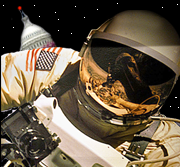Going Into Space? Get a License from NOAA Before Taking Pictures
 Recently, the National Oceanographic and Atmospheric Administration (NOAA) sent out a letter to participants of the X Prize, a sponsored, private-sector contest to create a reusable space vehicle.
Recently, the National Oceanographic and Atmospheric Administration (NOAA) sent out a letter to participants of the X Prize, a sponsored, private-sector contest to create a reusable space vehicle.
The letter stated that if participants actively or passively sense the Earth’s surface, including the use of electromagnetic waves emitted, reflected or diffracted, then they need to apply for a license. The application process could take up to 120 days.
At first blush, this seemed like a wildly insane notion, worthy of a rant. Indeed, there have been such rants, which is why the law blog Res Communis has shed some light on this notion. The blog, run by the University of Mississippi School of Law, and deals with space law. Apparently, they received a ton of hits on this story, and they wanted to explain why NOAA sent the letter and why it is consistent with international policy.
Joanne Gabrynowicz (Editor of the Journal of Space Law, and Director of the National Center for Remote Sensing, Air, and Space Law) tells readers that when LandSat1 was launched in 1972, the US adopted the nondiscriminatory access policy towards space.
The policy was formulated to ensure open access to sensed data and to assuage the concerns of the rest of the world that the satellite would be used against them in the form of economic or other espionage. Not all nations agreed that openness of information was a good idea and others feared the satellites being used against them. The nondiscriminatory access policy stated that access to imagery would be available to all, on a nondiscriminatory basis, and any nation could directly download the data, if they also implemented the nondiscriminatory access policy. Canada was the first to do so, followed by numerous nations since then.
Over the years, the policy evolved and has been adopted by all remote sensing nations and is, arguably, the most important part of the U.N. The Principles Relating to Remote Sensing of the Earth from Outer Space. The nondiscriminatory access policy still applies to the Landsat satellites and a modified version can apply to non-federal, civil satellites. How, and to what degree, is determined on a case-by-case basis.
The licensing process also serves as an interface mechanism between the U.S. and its obligations at international law. The United States, along with other spacefaring nations, is a State Party to the Outer Space Treaty. Under Article 6 of that Treaty, signatories, including the U.S., have the obligation to supervise and authorize all of their non-governmental space actors. Other signatories, including Canada, France, and Germany also have their own national analogs to the U.S. licensing process.
Initially, my layman’s ire was raised by the word “license.” How could NOAA license the Earth? (I thought Viacom was trying to do that.) But this actually makes sense. After reading this opinion, I came to see the word “license” in the same sense as a “permit” that one needs to acquire when hiking or camping in certain parks or forests. It’s a way to track activities, not restrict them. Certainly with all that space junk up there, the red copy probably gets forwarded to NORAD.
I guess the big take-away is that space law is a robust field. It therefore holds that there are space lawyers and space paralegals. One small step for law; one giant leap for billable hours.
After four years, I can’t believe Alan Shore didn’t get a Space Case … or was that Denny Crane?

 The future of digital experiences will be built by strategists who grasp the full array of emerging business, social, and technical models. Specialties in user experience, branding, application design, and data science are laying the foundation for richer user experiences and business models breakthrough products and revenue based marketing.
The future of digital experiences will be built by strategists who grasp the full array of emerging business, social, and technical models. Specialties in user experience, branding, application design, and data science are laying the foundation for richer user experiences and business models breakthrough products and revenue based marketing.